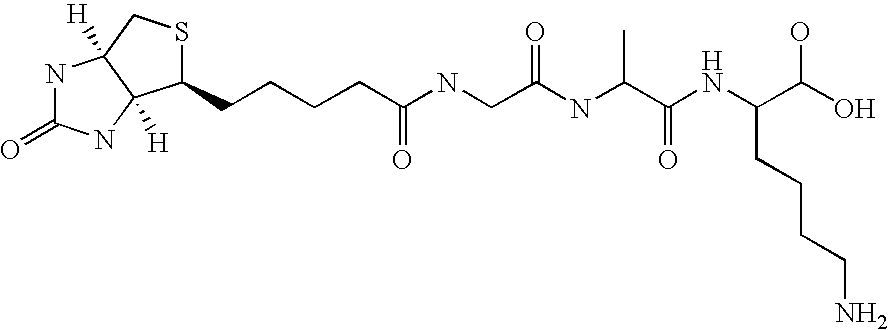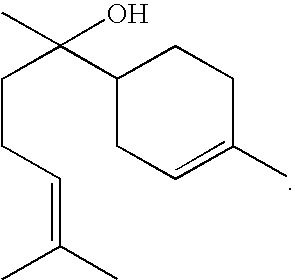Formulations and method for treating baldness
a baldness and formulation technology, applied in the field of formulations and methods for treating baldness, can solve the problems of fine alopecia hair, follicle shutting down or even dying,
- Summary
- Abstract
- Description
- Claims
- Application Information
AI Technical Summary
Benefits of technology
Problems solved by technology
Method used
Image
Examples
example 1
Study of Biotinyl-GHK on Cultured Hair Follicle Explants
[0230] A study was conducted on human skin explants cultured in PBS medium in a moist chamber at 21° C. Six explants containing hair follicles were incubated in the presence of 60 ppm biotinyl-GHK for 18 hours and compared to control explants exposed to a peptide-free excipient. This procedure was repeated in three batches. After the 18 hours an 8 mm biopsy was removed from the center of each well and immediately frozen in liquid nitrogen. 15 μm thick sections of the follicle were made using a freezing microtome which were then dried and fixed. Biotinyl-GHK in the sections was detected by immunolabeling coupled with streptavidine peroxidase. This was done to investigate for selective localization of the product around the pilial zone. The sections showed a clear peri-pilial localization of peptide biotinyl-GHK. This shows that biotinyl-GHK is a substantive peptide that exhibits specific localization around its target, the hair...
example 2
Anti-Aging Study on Cultured Hair Follicles
[0231] Excess hair follicles prepared in the context of a micrograft transplantation session were collected for culturing in a medium similar to that reported in, and herein encorporated by reference, Philpott et al., Whole Hair Follicule Culture, Dermatologic Clinics 595 (Oct. 14, 1996). Said hair follicles were then individually incubated at 37° C. under an air plus CO2 (at 5%) atmosphere for 14 days. The explants were then divided into four groups: 1) a control group for the culture medium alone, 2) a positive control group which was exposed to a medium of 2 ppm Minoxidil®, 3) a test group exposed to the peptide biotinyl-GHK in a medium of 2 ppm biotinyl-GHK, and 4) a test group exposed to the peptide biotinyl-GHK in a medium of 5 ppm biotinyl-GHK. The culture medium was changed every 2 days. General morphology was observed on Day 1 and Day 14. Concomitantly, a fraction of the follicles were frozen for the purposes of conducting more ad...
example 3
Anti-Aging Activity on the Root Sheath
[0232] The frozen microtome sections made on Day 0 and Day 14 from Example 2 were exposed to peroxidase-bound anti-Ki67 antibody. The dividing cells of these sections were stained dark brown. A count of cells showing the Ki67 marker was conducted on the lower section of the root sheath of the hair shaft under microscope. The count of the control bulb on Day 14 of the culture showed a decrease in mitotic keratinocytes, thereby reflecting cell aging. The positive control group, that exposed to a 2 ppm Minoxidil® medium, maintained proliferative activity as did the test groups exposed to 2 ppm and 5 ppm biotinyl-GHK mediums. However, the test group exposed to the 2 ppm biotinyl-GHK medium experienced superior proliferative activity to that obtained by Minoxidil® as reported by BOYERA et al., 1997. These results demonstrate that biotinyl-GHK exhibits an anti-aging effect on the keratinocytes of the control bulb.
PUM
| Property | Measurement | Unit |
|---|---|---|
| average primary particle size | aaaaa | aaaaa |
| average primary particle size | aaaaa | aaaaa |
| average primary particle size | aaaaa | aaaaa |
Abstract
Description
Claims
Application Information
 Login to View More
Login to View More - R&D
- Intellectual Property
- Life Sciences
- Materials
- Tech Scout
- Unparalleled Data Quality
- Higher Quality Content
- 60% Fewer Hallucinations
Browse by: Latest US Patents, China's latest patents, Technical Efficacy Thesaurus, Application Domain, Technology Topic, Popular Technical Reports.
© 2025 PatSnap. All rights reserved.Legal|Privacy policy|Modern Slavery Act Transparency Statement|Sitemap|About US| Contact US: help@patsnap.com



